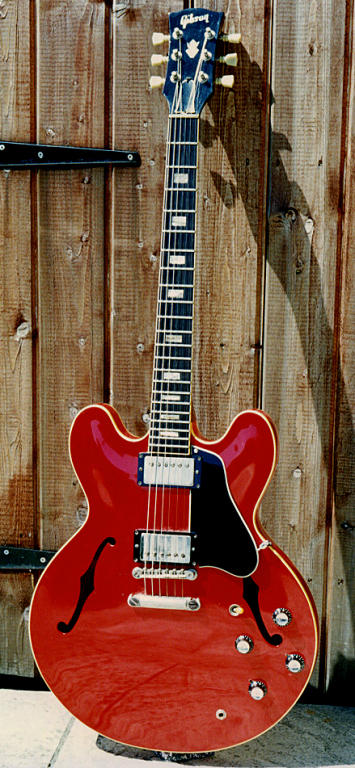There can be few guitarists with blood in their veins that don't go dewy-eyed over these gorgeous guitars. Yet another genius creation from Ted McCarty's design team at Gibson, the ES-335, launched in 1958, introduced a new concept in slim-line, semi-acoustic electrics that appealed as much to jazz and orchestra musicians as they did to pop and rock players. Loaded with their recent humbucking noise-cancelling pick-ups, and in a choice of three colours—natural, sunburst and the new-for-'58 cherry—they were an instant success, playing and sounding as fabulous as they looked. You bet I wanted one.
Having returned home to Purton in 1977 and taken a job delivering parcels for White Arrow, I was, after six months of saving, sufficiently in funds to go shopping for another guitar. In January 1978, this guitar appeared in the Melody Maker classifieds and, having made the call, I pointed my Peugeot 404 eastbound to London to check it out. The guy in the dimly-lit house in Chiswick showed me in and fetched it out.
Oh dear! It was a wreck. The headstock had been smashed off and bodged with what looked like a piece of 4×2 glued in with Araldite, much of which had found its way all over the neck—the back of which had had all its lacquer scratched off. The plastic body-bindings looked as if someone had tried to saw them off with a hack-saw, and there were deep gouges all over the top of the body. The pick-guard was missing. Other than that, it was perfect! I'd driven over 80 miles so I figured I'd at least have a play on it.
And that, my friends, was the moment that guitar was sold. That an instrument could suffer so much abuse, yet still out-perform practically every other guitar I'd played up to that point, speaks volumes for the magical properties these old Gibsons possess. Thirty years on, I'm still in love with it.
I kept it in pretty much the condition I'd bought it for about six years. The previous owner had coil-tapped the pickups which, together with the dodgy headstock repair, gave the guitar a uniquely wiry tone just perfect for the hard-edged punk/R'n'B I'd been playing with my band Dean Gabber And His Gaberdines. I took it on the road for my first couple of UK tours with XTC, promising myself I'd get the guitar put right as soon as I had the money. In the spring of 1984 I met Hugh Cornwell, then of the Stranglers, at Crescent Studios in Bath while we were working on The Big Express. It was he who recommended I visit the Kinkade Brothers, Jonny and Simon, in Bristol, who had made a number of excellent guitars for himself and JJ Burnel. That began a relationship with Jonny that continues to this day, many of my guitars having benefited from his brilliant workmanship over the years.
The priority was the neck and headstock. Jonny and Simon made a new head, lifting the pearl inserts out of the old one and inlaying them into the new veneer. Then the neck was re-fretted and the bindings were repaired, before the whole guitar was re-lacquered. I loved the water-melon red of my 1960 ES-355, slightly brighter than the usual cherry, so took it to them as a colour reference. They did a beautiful job, though I now consider the brighter red looks best with gold-plated hardware.
One thing was lost forever. With the headstock now professionally repaired, the guitar sounds exactly like every other early-1960s ES-335. That peculiarly nasal twang when the bridge pickup was tapped was an accident resulting from the botched repair done by the previous owner, proving beyond doubt the significance of the neck to the sound of a guitar. Not that I'm complaining; I'll still be loving this instrument thirty years from now.
| Recording debut | |
|---|---|
| XTC |
|
| Features on | |
| XTC |
|
| Peter Gabriel |
|
